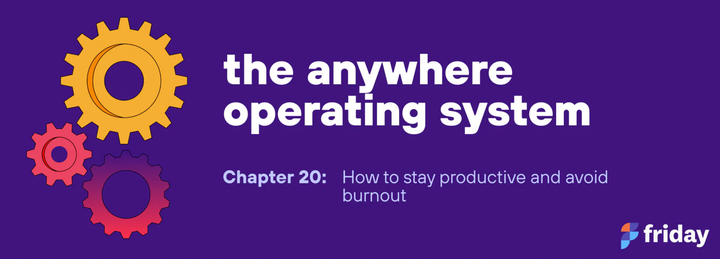Chapter 19: what about hybrid work?

This chapter originally appeared on the Zapier blog.
As a byproduct of the pandemic, many companies have decided to implement a hybrid approach where people work from home a couple days a week, with the option to visit the office 1-2 days/week for collaborative activities, team bonding, and meetings. In fact, this mode of work may be the “new normal.”
On the surface, this makes a ton of sense and fits neatly into the work-from-anywhere framework proposed earlier in the book. In reality, there’s some hidden complexity you will need to deal with that you may be underestimating right now.
In this chapter, I’m going to discuss the benefits and pitfalls of hybrid work. Similar to working remotely, many forward-thinking companies were already offering this work model before the pandemic started, so we don’t need to reinvent the wheel.
The gravitational pull to hybrid
The rationale behind a hybrid work environment is straightforward. Working from home has benefits, like being able to focus and do deep work without distractions. Working from an office has benefits, like water cooler discussion and the ability to grab lunch with coworkers on a whim.
Some people on your team would prefer to work from home a few days a week, while others would like to work from the office every day of the week. Another group would love to ditch the office completely and live a thousand miles away from the HQ.
As a company, what do you do? Different people have different preferences. If you are too opinionated, you could alienate a portion of your company, which may cause employee turnover. If you don’t have an opinion, you might inadvertently create chaos.
What are your options?
Contrary to what you might read online, there are many flavors of hybrid that you can pursue.
- You can be fully remote, but encourage people to meet up in person when it makes sense (like offering to pay for a group lunch)
- If you have enough density of talent in a particular city, you could pay for co-working space for the team
- You could keep your office space, but create a rigid policy around meeting up in person, (i.e., only meet up for high-level brainstorming, team lunches, and quarterly performance conversations).
- You could expense co-working space for individuals who need to get out of the house
- You could encourage team leaders to use their best judgement and push down the decision to them.
Which format should you decide?
First of all, there is no perfect solution. Whatever decision you make will have advantages and disadvantages. You need to focus on maximizing the upside (both for the business and the employee), while reducing the potential downside.
So how might you make this decision?
1. Think about talent
As a starting point, you need to think about the existing team and potential future hires. If you return to the office (even a few days a week), will this decision limit the pool of talent you can hire? If you force employees to come back to the office for a couple days a week, you are creating a geographical constraint as your team will still need to commute to the office.
2. Talk to your team
Consider running a survey or holding small focus groups to understand where your team falls. It’s possible that the right answer will become obvious in the data, but don’t be surprised if 60% want a hybrid work environment, 20% want fully remote, and another 20% want to return to the office. You should expect the survey responses to follow a standard distribution curve.
3. Have an opinion
At the end of the day, you need to take a stance and make it known to the rest of the company, ideally in writing. There is no perfect solution. If you wait too long, people on your team will leave because of your indecision. Some of your employees may consider moving elsewhere, but they are waiting for you to make up your mind.
Issues with hybrid work
If you decide to pursue a hybrid model, there are a few potential issues that you should try to avoid.
1. You need to be intentional about sharing information
As you meet and collaborate in the real-world, you will build up institutional knowledge inside your team that will not magically flow to the remainder of the company unless you regularly document the highlights of your conversation and share it with others, asynchronously.
This may feel like extra work to you. You are right! It’s not easy to change habits. This is why many remote-first companies are not fans of hybrid work arrangements. If you don’t create a habit, some members of your team will feel disconnected and out of the loop as you’ve created an uneven playing field.
2. Cliques will form if you aren’t careful
Next up, in a hybrid work environment, certain relationships between coworkers will deepen, while others will not. For example, if you only meet up with immediate team members in person, you will naturally get to know them vs. people on other teams. This can create an “us vs. them” mentality. In psychology, this is known as the in-group vs. the out-group.
While this dynamic is unavoidable at work (as you will always spend more time with immediate team members compared to people in other departments), if you aren’t intentional, you could create a toxic environment without even trying.
To illustrate, at a company for which I used to work, employees were given flexibility around when they could go into the office. One group would visit on specific days of the week. Relationships strengthened for this team at the expense of their coworkers. Other people would show up to the office and were not invited to lunch. In short, this team acted like they were the only ones in the office, which caused tension.
3. You will still need to make difficult decisions
At the end of the day, if you think a hybrid work environment is a path to avoid making tough decisions for your company, you will be disappointed. You will still need to create high-level policies, coordinate desks, and a lot more. In fact, you will need to do more coordination than if you made a decision to go fully remote or 100% back to the office.
For example, I worked at a company where every employee (even if they were in the office) needed to join video calls on their own computer instead of using a shared webcam in a conference room. This policy was an effort to include remote employees as first-class citizens. We should expect hybrid organizations will need to create their own operating procedures in a similar fashion, which takes work!
4. Relying on in-person discussion can become a crutch
Another pitfall I’ve experienced working inside a hybrid organization is that there’s a tendency to delay important conversations until you meet in person. For example, I worked at a company that had an annual company onsite. Two months before the company onsite happened, teams would create placeholders for future discussion and would say, “we should discuss this topic at the meet-up.”
This was a terribly unproductive approach. Day-to-day work ground to a halt for at least a month; and while the company meet-up was amazing, punting decisions created an enormous bottleneck.
The WFA movement is about freeing up each person to run at their own pace. If you need to meet in person to make an important decision, you are creating roadblocks that will slow your company down.
4. You can't work every day from the office
As a leader, you will need to be intentional about how much time you spend in the office. You may need to force yourself to work from home. If the leadership team works out of the office five days a week, this behavior lays a foundation for the rest of the company, especially those who want more responsibility or a promotion. Basically, if someone wants to be promoted, they need to come into the office everyday to make sure that the leadership team sees them. This phenomenon is known as the mere exposure effect. People develop a preference for something after repeated interactions. If you aren't careful, you can create a toxic work environment.
5. You need to create a level playing field in meetings
Finally, it's easy to create an uneven playing field in meetings. Imagine a hybrid meeting with group of people in a conference room and a few people joining remotely. The group in the conference room may forget about the remote team members as they are "out of sight, out of mind". The conversation amongst those in the same location is much faster-paced and richer. The people joining remotely don't have nearly as much of a signal and it can be tricky to keep up. This dynamic makes it difficult for the remote team members to participate. The remote team members have a handicap compared to those in the office.
I first ran into this problem almost five years ago at a previous employer. The CEO forced everyone to join meetings via Zoom, even for those were working out of the office. At first, I thought this was a terrible idea, but after time, I realized that it was brilliant. By putting everyone on a level playing field, you can have much more thoughtful meetings where everyone is encouraged to participate.
How we work at Friday
I think it’s helpful to share how we work at Friday to help illustrate some of these points. I’ve decided that I want to hire the best people I could find, regardless of location. As a result, our team is scattered across six time zones. I will always optimize for finding talented people over location. That’s the most important factor.
With that being said, we have clustered US-based hires around two cities: - Portland, Maine, and Nashville, Tennessee. If I can find someone in one of these cities, I will happily make the hire.
Even though we have grouped our US-based hiring in two cities, we are still an all-remote company. I work from home every day, even though I live 20 minutes away from a few of my coworkers. We will try to meet in-person periodically, but it’s something that happens once in a while instead of every week.
In short, I consider being able to meet up in person regularly as a nice to have, not a must have.
In conclusion
At Friday, the primary goal of meeting up in person is to hang out, grab lunch, and enjoy each other’s company. If you pursue a hybrid work model, I’d encourage you to adopt a similar mindset.
If you try to introduce too much complexity, it will distract you from growing your business and will create problems. There is no perfect solution: talk to your team, experiment, and make changes as you learn.
Want to keep going? Read the next chapter where we discuss how to stay productive and eliminate burnout.


